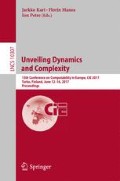Abstract
The delayed-input witness-indistinguishable proof of knowledge of Lapidot and Shamir (LS) [CRYPTO 1989] is a powerful tool for designing round-efficient cryptographic protocols. Since LS was designed for the language of Hamiltonian graphs, when used as subprotocol it usually requires expensive NP reductions.
We first overview how LS works, how it can be used to obtain round-efficient protocols as shown by Ostrovsky and Visconti [ECCC 2012] and why it suffers of intrinsic efficiency limitations.
Then we will overview some recent advances on delayed-input cryptographic protocols and their applications. We will in particular consider the efficient witness-indistinguishable proofs of knowledge of Ciampi, Persiano, Scafuro, Siniscalchi and Visconti [TCC 2016a, Eurocrypt 2016], and the round-efficient non-malleable commitments of Ciampi, Ostrovsky, Siniscalchi and Visconti [Crypto 2016, Eprint 2016].
Access this chapter
Tax calculation will be finalised at checkout
Purchases are for personal use only
References
Barak, B.: How to go beyond the black-box simulation barrier. In: 42nd Annual Symposium on Foundations of Computer Science, FOCS 2001, 14–17 October, Las Vegas, Nevada, USA, pp. 106–115. IEEE Computer Society (2001)
Chung, K.-M., Ostrovsky, R., Pass, R., Venkitasubramaniam, M., Visconti, I.: 4-round resettably-sound zero knowledge. In: Lindell, Y. (ed.) TCC 2014. LNCS, vol. 8349, pp. 192–216. Springer, Heidelberg (2014). doi:10.1007/978-3-642-54242-8_9
Ciampi, M., Ostrovsky, R., Siniscalchi, L., Visconti, I.: 4-round concurrent non-malleable commitments from one-way functions. IACR Cryptology ePrint Archive 2016, 621 (2016). http://eprint.iacr.org/2016/621
Ciampi, M., Ostrovsky, R., Siniscalchi, L., Visconti, I.: Concurrent non-malleable commitments (and more) in 3 rounds. In: Robshaw, M., Katz, J. (eds.) CRYPTO 2016. LNCS, vol. 9816, pp. 270–299. Springer, Heidelberg (2016). doi:10.1007/978-3-662-53015-3_10
Ciampi, M., Persiano, G., Scafuro, A., Siniscalchi, L., Visconti, I.: Improved OR-composition of sigma-protocols. In: Kushilevitz, E., Malkin, T. (eds.) TCC 2016. LNCS, vol. 9563, pp. 112–141. Springer, Heidelberg (2016). doi:10.1007/978-3-662-49099-0_5
Ciampi, M., Persiano, G., Scafuro, A., Siniscalchi, L., Visconti, I.: Online/offline OR composition of sigma protocols. In: Fischlin, M., Coron, J.-S. (eds.) EUROCRYPT 2016. LNCS, vol. 9666, pp. 63–92. Springer, Heidelberg (2016). doi:10.1007/978-3-662-49896-5_3
Cramer, R., Damgård, I., Schoenmakers, B.: Proofs of partial knowledge and simplified design of witness hiding protocols. In: Desmedt, Y.G. (ed.) CRYPTO 1994. LNCS, vol. 839, pp. 174–187. Springer, Heidelberg (1994). doi:10.1007/3-540-48658-5_19
Damgård, I.: On \(\varSigma \)-protocols (2010). http://www.cs.au.dk/~ivan/Sigma.pdf
Crescenzo, G., Persiano, G., Visconti, I.: Constant-round resettable zero knowledge with concurrent soundness in the bare public-key model. In: Franklin, M. (ed.) CRYPTO 2004. LNCS, vol. 3152, pp. 237–253. Springer, Heidelberg (2004). doi:10.1007/978-3-540-28628-8_15
Crescenzo, G., Persiano, G., Visconti, I.: Improved setup assumptions for 3-round resettable zero knowledge. In: Lee, P.J. (ed.) ASIACRYPT 2004. LNCS, vol. 3329, pp. 530–544. Springer, Heidelberg (2004). doi:10.1007/978-3-540-30539-2_37
Goyal, V., Richelson, S., Rosen, A., Vald, M.: An algebraic approach to non-malleability. In: 55th IEEE Annual Symposium on Foundations of Computer Science, FOCS 2014, Philadelphia, PA, USA, 18–21 October, pp. 41–50 (2014)
Hazay, C., Venkitasubramaniam, M.: On the power of secure two-party computation. In: Robshaw, M., Katz, J. (eds.) CRYPTO 2016. LNCS, vol. 9815, pp. 397–429. Springer, Heidelberg (2016). doi:10.1007/978-3-662-53008-5_14
Katz, J., Ostrovsky, R.: Round-optimal secure two-party computation. In: Franklin, M. (ed.) CRYPTO 2004. LNCS, vol. 3152, pp. 335–354. Springer, Heidelberg (2004). doi:10.1007/978-3-540-28628-8_21
Lapidot, D., Shamir, A.: Publicly verifiable non-interactive zero-knowledge proofs. In: Menezes, A.J., Vanstone, S.A. (eds.) CRYPTO 1990. LNCS, vol. 537, pp. 353–365. Springer, Heidelberg (1991). doi:10.1007/3-540-38424-3_26
Mittelbach, A., Venturi, D.: Fiat–shamir for highly sound protocols is instantiable. In: Zikas, V., Prisco, R. (eds.) SCN 2016. LNCS, vol. 9841, pp. 198–215. Springer, Cham (2016). doi:10.1007/978-3-319-44618-9_11
Ostrovsky, R., Visconti, I.: Simultaneous resettability from collision resistance. Electronic Colloquium on Computational Complexity (ECCC) 19, 164 (2012)
Wee, H.: Black-box, round-efficient secure computation via non-malleability amplification. In: 51th Annual IEEE Symposium on Foundations of Computer Science, FOCS 2010, 23–26 October, Las Vegas, Nevada, USA, pp. 531–540. IEEE Computer Society (2010)
Yung, M., Zhao, Y.: Generic and practical resettable zero-knowledge in the bare public-key model. In: Naor, M. (ed.) EUROCRYPT 2007. LNCS, vol. 4515, pp. 129–147. Springer, Heidelberg (2007). doi:10.1007/978-3-540-72540-4_8
Acknowledgments
I thank my coauthors Michele Ciampi, Rafail Ostrovsky, Giuseppe Persiano, Alessandra Scafuro and Luisa Siniscalchi for the good time that we have spent together working on delayed-input cryptographic protocols. I also thank Helger Lipmaa for valuable comments on a preliminary version of this paper. This work has been supported in part by “GNCS - INdAM”, in part by University of Salerno through grants FARB-2014/2015 and in part by the EU COST Action IC1306.
Author information
Authors and Affiliations
Corresponding author
Editor information
Editors and Affiliations
Rights and permissions
Copyright information
© 2017 Springer International Publishing AG
About this paper
Cite this paper
Visconti, I. (2017). Delayed-Input Cryptographic Protocols. In: Kari, J., Manea, F., Petre, I. (eds) Unveiling Dynamics and Complexity. CiE 2017. Lecture Notes in Computer Science(), vol 10307. Springer, Cham. https://doi.org/10.1007/978-3-319-58741-7_12
Download citation
DOI: https://doi.org/10.1007/978-3-319-58741-7_12
Published:
Publisher Name: Springer, Cham
Print ISBN: 978-3-319-58740-0
Online ISBN: 978-3-319-58741-7
eBook Packages: Computer ScienceComputer Science (R0)

